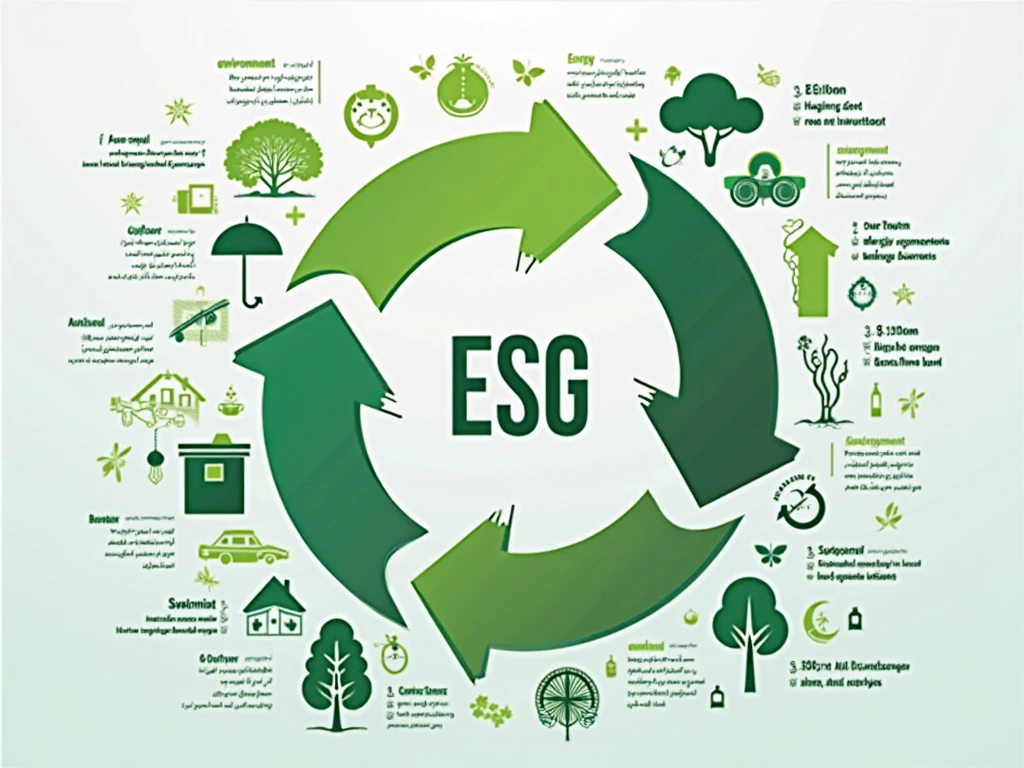Ai in ESG reporting in 2025 : A Roadmap for Sustainable Governance
If you’re looking to invest responsibly while maximizing long-term returns, understanding the evolving ESG landscape in 2025 is essential. Whether you’re new to Environmental, Social, and Governance (ESG) principles or already incorporating them into your portfolio, the complexities and opportunities of ESG investing continue to grow.
This guide will walk you through the core aspects of ESG investing, the latest trends, the role of rating agencies, risk management, and how you can position yourself to thrive as the landscape shifts. By the time you finish reading, you’ll be better equipped to make informed decisions aligned with your values and financial goals.

Ai in ESG reporting in 2025 : What Are the Key Trends ?
Understanding the Ai in ESG reporting in 2025: What Investors Need to Know
What is ESG ? Breaking Down Environmental, Social, and Governance Factors
At its core, ESG refers to three central pillars used to evaluate companies beyond traditional financial metrics:
- Environmental: This covers a company’s impact on nature—think carbon footprint, waste management, water usage, and energy efficiency. With climate change at the forefront of global concerns, understanding a company’s environmental practices helps you invest in businesses contributing to a healthier planet.
- Social: This pillar examines how a company manages relationships with employees, suppliers, customers, and the communities where it operates. Factors like labor practices, diversity and inclusion, human rights, and community engagement all come into play.
- Governance: Governance looks at internal systems and controls—board diversity, executive compensation, business ethics, transparency, and shareholder rights. Strong governance means the company is better positioned to avoid scandals and align management with shareholder interests.
By factoring these in, ESG investing lets you assess companies on sustainability and ethics alongside profit potential.
The Growing Importance of ESG in Investment Decisions

More than ever, investors like you demand that your money does good while doing well. Global challenges such as climate change, social inequality, and corporate misconduct have prompted a surge in interest toward sustainable investments.
ESG isn’t just a buzzword—it has become a core strategy for managing risks and identifying growth opportunities. Studies show companies with robust ESG practices often demonstrate greater resilience and, over time, better financial performance.
By integrating ESG considerations, you safeguard your investments against regulatory shocks, reputational damage, and supply chain disruptions.
Key ESG Metrics and Reporting Standards: GRI, SASB, and TCFD
To make informed choices, you need reliable data. ESG reporting standards help companies disclose relevant information consistently. Among the most influential frameworks are:
- Global Reporting Initiative (GRI): Widely adopted globally, GRI standards guide companies in disclosing sustainability impacts across economic, environmental, and social dimensions.
- Sustainability Accounting Standards Board (SASB): SASB focuses on financially material sustainability factors relevant to investors, tailored by industry.
- Task Force on Climate-related Financial Disclosures (TCFD): TCFD helps companies report climate-related risks and opportunities, emphasizing transparency in how climate factors impact financial health.
Familiarizing yourself with these standards helps you evaluate ESG disclosures critically and compare companies effectively.
How ESG Differs from Traditional Investment Approaches
Traditional investing largely focuses on financial indicators like earnings, revenue, and market trends. ESG investing adds layers of sustainability and ethical evaluation, broadening your perspective on risk and opportunity.
Rather than choosing investments based solely on expected returns, ESG pushes you to consider how companies impact society and the environment—and how these factors might affect long-term value.
Current Trends Shaping ESG Investing in 2025
Rise of ESG-Focused Funds and ETFs
The market has responded to growing ESG demand with a proliferation of ESG funds and ETFs. These products pool investor capital to buy shares in companies meeting ESG criteria, offering a convenient way for you to diversify responsibly.
In 2025, expect continued innovation—more thematic ETFs targeting clean energy, gender diversity, or low-carbon technologies are emerging, enabling you to align investments even more precisely with your values.
Integration of Climate Risk into ESG Frameworks
Climate change is no longer a distant worry; it’s a financial reality. Incorporating climate risk into ESG analysis has become critical.
This means evaluating a company’s exposure to physical climate impacts like extreme weather and transition risks like new regulations or shifting consumer preferences. You can expect ESG evaluations to increasingly focus on how businesses prepare for and mitigate climate-related risks.
Increasing Demand for Transparent ESG Ratings and Scores
With ESG investing gaining popularity, there’s rising demand for transparency and standardization in ESG ratings.
You want clarity on how ratings are calculated, the data used, and any potential biases. In 2025, rating agencies are under pressure to improve methodology consistency and disclosure, helping you trust the ESG scores guiding your investments.
Regulatory Developments: SEC, European Green Deal, and Beyond
Regulation is shaping the ESG landscape more than ever. The U.S. Securities and Exchange Commission (SEC) has introduced new rules requiring enhanced ESG disclosures for public companies, while the European Green Deal drives sustainability standards across the EU.
Staying informed about these developments helps you anticipate shifts in corporate behavior and ensures your investments comply with emerging norms.
The Role of ESG Rating Agencies and Frameworks
Overview of Leading ESG Rating Agencies: MSCI, Sustainalytics, Refinitiv
To navigate ESG data, rating agencies provide assessments of companies’ sustainability performance:
- MSCI evaluates ESG risks and opportunities, offering detailed scores by industry and geography.
- Sustainalytics focuses on ESG risk exposure and management, widely used by asset managers.
- Refinitiv provides comprehensive ESG data integrated into financial analytics platforms.
Knowing which agency’s methodology aligns with your priorities helps you interpret scores effectively.
How ESG Ratings Impact Investment Choices and Corporate Behavior
ESG ratings influence not just investors but companies themselves. A high rating can attract capital, improve reputation, and drive better management practices.
As an investor, paying attention to these scores helps you identify companies making real progress on sustainability and avoid those facing ESG controversies.
Challenges and Criticisms of ESG Rating Methodologies
However, ESG ratings aren’t perfect. Differences in criteria, weighting, and data quality can cause significant variation across agencies.
You should use ratings as one tool among many, combining them with your own research and judgment rather than relying solely on a single score.
Aligning Corporate Sustainability Strategies with ESG Expectations
Many companies are adjusting strategies to meet rising ESG demands—from reducing emissions to enhancing diversity initiatives.
By monitoring how well companies integrate ESG into their core business, you can identify leaders poised for sustainable growth.
Navigating ESG Risks and Opportunities for Investors
Identifying ESG Risks: Environmental and Social Challenges
Investing with ESG in mind means actively assessing risks:
- Environmental risks like pollution, resource depletion, and climate change can disrupt operations and supply chains.
- Social risks include labor disputes, human rights violations, and negative community impact, which may result in reputational harm or legal issues.
Recognizing these risks helps you avoid investments that may face costly challenges down the road.
Leveraging ESG Opportunities for Long-Term Returns
Conversely, ESG investing uncovers opportunities in sectors driving sustainability—renewable energy, clean technology, sustainable agriculture, and social innovation.
By backing companies addressing global challenges, you can benefit from growth in these expanding markets while making a positive impact.
Impact Investing and Socially Responsible Investing (SRI) Strategies
Beyond screening out harmful companies, impact investing focuses on generating measurable social or environmental benefits alongside financial returns.
Socially responsible investing (SRI) allows you to invest based on personal values, whether it’s supporting gender equality, avoiding fossil fuels, or promoting fair labor practices.
The Role of Active Engagement: Climate Action 100+ and Shareholder Advocacy
You also have the power to influence companies as a shareholder. Initiatives like Climate Action 100+ mobilize investors to pressure corporations on emissions reduction and climate governance.
Engaging in proxy voting and dialogue encourages companies to improve ESG performance, aligning business practices with sustainability goals.
Preparing for the Future: How to Stay Ahead in the ESG Landscape

Adapting to Emerging ESG Regulations and Disclosure Requirements
Regulations are evolving rapidly. You’ll need to stay updated on disclosure rules affecting your investments and the companies you back.
Understanding compliance requirements helps you avoid risks linked to non-disclosure or misreporting.
Using Technology and Data Analytics for Better ESG Insights
Technology, including AI and big data analytics, is transforming how ESG information is collected and analyzed.
Leveraging these tools provides you with richer, more timely insights, enabling smarter investment decisions.
Building a Resilient, Sustainable Investment Portfolio
By combining ESG data with financial analysis, you can construct a portfolio that balances risk, return, and sustainability.
Diversify across sectors and geographies, prioritize companies with strong ESG records, and regularly review your holdings to adapt to market shifts.
The Future of ESG: Predictions and Innovations for 2026 and Beyond
Looking ahead, expect greater standardization in ESG reporting, deeper integration of climate science into financial models, and more hybrid human-AI advisory services.
Staying flexible and informed will ensure you continue to benefit from ESG-driven innovation.
Empowering Your Investment Journey with ESG in 2025
Navigating the ESG landscape may seem complex, but with the right knowledge and tools, you can confidently align your investments with both your values and financial goals. ESG investing isn’t just about avoiding harm—it’s about actively contributing to a sustainable future while capturing growth opportunities.
Start by educating yourself on ESG principles, exploring diverse funds, and using ratings wisely. Keep an eye on regulatory changes and leverage technology to stay ahead.
The future favors investors who blend financial acumen with social responsibility—make that investor you.
Are you ready to make your portfolio more sustainable and resilient? Begin by reviewing your current investments through an ESG lens today.
Consider consulting ESG-focused financial advisors or exploring ESG ETFs that match your values. Together, you can build a future-proof investment strategy that benefits both your wallet and the world.


